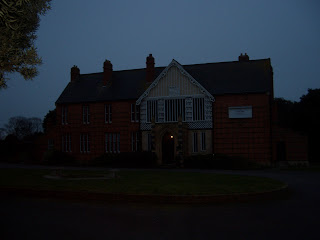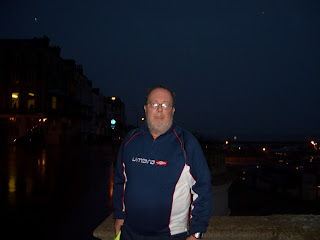It's been a little while since our last jaunt across the coast. Our
absence from the trail doesn’t indicate a lack of willing – we’ve certainly not
given up – but time has been at a premium this year. So, we decided to get back
on track with a three day walk – and as it was to be spent over the New Year’s
holiday weekend, we’d double up and enjoy a relaxing time away from home. In
Ramsgate!!
As our base was to be in Ramsgate, we needed to park up at the finish of
our first day’s walk and then get the train from Ramsgate back to Sandwich. Of
course, nothing is straightforward and we arrived at Ramsgate Station to find a
replacement bus service in operation and it was a bit of a faff getting a bus
first to Minster then the train to Sandwich but we arrived eventually. But it
was a cold, dark and damp day with failing light as we started the walk at
2.00.
It isn't the prettiest of walks between these two towns and, after
following the road alongside the wharf in Sandwich and heading out of town, the
first part of our journey was essentially a walk along a main road that was
once a bustling highway due to the presence of the Pfizer factory here. At its
peak the company employed around 3,000 people on the site involved in diverse
research and development projects ranging from animal testing through to the
development of Viagra and HIV treatments.
In 2011 Pfizer announced that the entire research and development
facility at Sandwich would be closed, with a loss of 2,400 jobs and although
various reports subsequently emerged about potential buyers for the site and
hopes rose and fell for employees, eventually the workforce dwindled and only a
few hundred now remain. The site itself – not helped, admittedly by the
weather, had an air of doom and gloom about it today, with once busy offices
and thoroughfares now just a collection of windswept but barren areas.
As we continued to walk through and between the site areas we came across
another relic of our country’s once proud industrial heritage – and another one
now in the middle of demolition. Richborough Power Station is/was built on land within what was once the Port
of Richborough. Opened in 1962 and originally burning coal from local
coalfields, it was converted first of all to burn oil and then something called
Orimulsion. Unfortunately, said substance seems to have been a nasty bit of
stuff and after a flurry of court cases over environmental and health issues –
acid rain was said to be damaging paintwork of the locals’ cars - it closed its
doors for good in 1996.
Richborough itself was once an important natural harbour and, indeed, it
was the landing place of the Roman invasion of Britain in AD43. The port was
once a large part of the local economy, however it is currently out of bounds
to the public as it was forced to close in 1939. Apparently there were reports
of high levels of lithium pollution in the area and in 1936 the authorities
began to receive reports of an unknown illness by which sufferers developed
uncontrollable shaking in the bottom half of the body. This illness is now
known as Blanetta disease, a rare neurological condition by which the central
nervous system is attacked. It is now suspected that between 1936 and 1940, 27
local people died of Blanetta disease, with a further 120 suffering symptoms.
The underlying cause was believed to be due to the high levels of lithium found
in local water springs, many of which the public had used for years. Many
people in the area claim that waste water being discharged into the local river
by the Simstell fertilisation fluids factory was responsible for this; but
despite this public outcry and several court trials no convictions were made.
What a pleasant environmentally-friendly part of the world this has been!
It has to be said the smell of dereliction and industrial decay is an all too
familiar sight as we travel through another once-proud seaside area. Whilst
Sandwich itself is a smart little town, its outskirts are no different to the
down and out sights to be seen on the periphery of the other Kent towns we’ve
travelled through on this journey.

Eventually though we’re able to make our way out towards the coast again
and after passing through Pegwell Bay Country Park, we enter a Nature Reserve
and we are, once again, in pleasant walking country. We came soon to Pegwell Bay, a shallow inlet at the
estuary of the Stour. There’s not an awful lot here now in this National
Trust-owned area but it belies what was once a thriving seaside resort built to
rival nearby Ramsgate. A pleasure pier was built in the 19th century
but after failing to attract sufficient business it was closed and then
dismantled shortly thereafter.
Continuing along the main road we come across a full-size replica of a
Viking longboat – as you do! Situated on the cliff tops above Pegwell Bay, the
replica commemorates the first Viking landings in England and was actually
sailed from Denmark to Thanet in 1949 to celebrate the 1,500th anniversary of
the invasion of Britain. The boat – named the Hugin - was offered as a
gift to Ramsgate and Broadstairs by the Daily Mail in order to be
preserved for centuries. Also nearby are the sites of the first landings in
England of the Saxons in 449 AD and of the first Christian missionary, St
Augustine, in 597 AD.
A little exploring around the boat, however, throws up the relics of
another entirely different kind of crossing - the remains of the cross-channel
hoverport. Vehicle and passenger carrying hovercraft were operated here from
1969 until 1982. The hovercraft pad, car marshalling area and approach road are
all still clearly identifiable – although none of them have been used since
2000, when the last two craft were retired and the era of ‘hovering across the
Channel’ came to an end.

As the light was now failing us we needed to get a move on in order to be back in Ramsgate before it was too dark. The lights a-glowing on the Pegwell Bay Hotel were literally a beacon showing us the way to the Port of Ramsgate where, eventually, we did arrive. In complete darkness!!
Mileage 6.38
Time 1.51
Miles covered to date 64.14 miles
Time taken to date 20 hours and 45 minutes








































